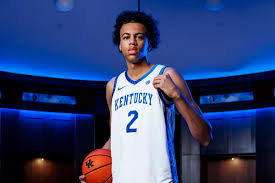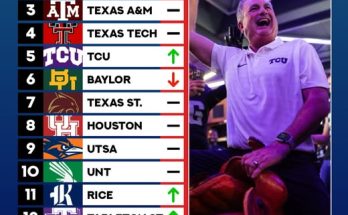Braydon Hawthorne’s recruitment had all the makings of another classic Duke basketball victory story—a talented, blue-chip prospect rising through the ranks, coveted by high-majors across the country, but ultimately swayed by the weight of tradition, NBA preparation, and the allures of playing under the bright lights of Cameron Indoor Stadium. Yet, when the dust settled, it was not the Blue Devils who came out on top.
Instead, in a twist few insiders saw coming, Hawthorne chose a different path—one that sent a ripple through the recruiting world and left the Duke coaching staff and fanbase stunned.
The 6-foot-6 shooting guard out of Monteverde Academy had been trending toward Duke for weeks, even months. He visited Durham in April, received the full royal treatment, and was reportedly enthusiastic about the program’s history and development track record. Many believed the visit had all but sealed the deal, especially given Duke’s recent success with similar high-caliber wings who went on to become NBA lottery picks. From Grant Hill to Brandon Ingram, Jayson Tatum, RJ Barrett, and most recently Cooper Flagg, Duke has long been the dream destination for elite perimeter players.
But Hawthorne’s decision defied expectations.
In a social media post shared late Wednesday evening, Hawthorne revealed he would be taking his talents to the University of Alabama—sending a powerful message not only about the shifting landscape of college basketball recruiting but also about how schools outside the traditional blueblood circle are making legitimate runs at top-tier talent. For Duke, it was a rare miss, and a frustrating one at that, given how much energy and attention had gone into his recruitment.
Sources close to the Duke program indicated that head coach Jon Scheyer and his staff had made Hawthorne a priority target. His visit had included not only extensive time with the coaching staff but also one-on-one interactions with current players, academic advisors, and even a special film session designed to showcase how Hawthorne could immediately fit into the Blue Devils’ system. He was envisioned as a dynamic two-way player, capable of guarding multiple positions and thriving in Duke’s motion-heavy offense. More than that, he was seen as a player who could follow the Flagg blueprint—arriving with fanfare, producing on both ends, and departing after one year for the NBA as a top-10 pick.
So, what changed?
According to insiders, the recruitment took a turn in recent weeks. Alabama had been involved from the start, but most analysts considered them a distant second to Duke and Kansas. However, Nate Oats and the Crimson Tide staff apparently stepped up their efforts in the final stages of the process. What made the difference, according to a source familiar with Hawthorne’s decision, was a combination of NIL opportunities, the team’s up-tempo offensive system, and Alabama’s recent success in the NCAA Tournament.
Indeed, Alabama’s ascent in the college basketball hierarchy has been remarkable. Under Oats, the Tide have reached new heights, including a Final Four berth and multiple top-five recruiting classes. Their emphasis on spacing, pace, and freedom for guards has become a calling card, and it seems that style resonated with Hawthorne.
“Braydon is a player who wants to be unleashed,” said a national recruiting analyst. “He sees himself as a future NBA star, and Alabama made it clear they’ll give him the runway to do that. He loved the idea of playing in a fast system that gives its guards room to create.”
It’s a gut punch for Duke, especially given how rare it is for the Blue Devils to lose out on a priority recruit they hosted so recently. Scheyer and his staff have done an admirable job maintaining Duke’s recruiting dominance in the post-Coach K era, consistently landing five-star talent and competing for national titles. But in today’s environment—where NIL plays a major role, and players are increasingly prioritizing fit over tradition—even a brand as strong as Duke’s isn’t immune to surprises.
Hawthorne’s decision also reflects a broader theme in college basketball: the decentralization of power. For decades, programs like Duke, North Carolina, Kentucky, and Kansas could count on securing nearly every top prospect they targeted. But now, schools like Alabama, Houston, Baylor, and even mid-majors with strong NIL collectives are becoming more than just respectable destinations—they’re contenders.
For Hawthorne, the choice appears to be more than just basketball. His family reportedly visited Tuscaloosa and came away impressed with the support structure in place for athletes. In interviews, Braydon has often spoken about the importance of development—not just on the court but off it. Alabama’s pitch, sources say, included a strong emphasis on personal growth, branding, and professional readiness. NIL collectives tied to the university made compelling offers, but the decision, according to Hawthorne’s camp, was “not all about money.”
Still, Duke fans will be left wondering what more could have been done. It’s not often that the Blue Devils miss out on a player they hosted so late in the recruiting cycle. The optics sting, especially when so many signs pointed to Durham being the favorite. And while Duke’s 2025 recruiting class still boasts major talent, the loss of Hawthorne leaves a noticeable gap.
Scheyer, to his credit, took the high road in comments made after the announcement. “Braydon is a great young man and an exceptional player,” he said. “We wish him the best in his future. Recruiting is always competitive, and we’re proud of the guys we’ve brought in and the culture we continue to build here.”
It’s a classy response, and one that reflects the professionalism Scheyer has displayed since taking over the program. Still, this recruitment will be studied for months, perhaps years, as an example of how even Duke must adapt to the changing realities of college basketball. The old blueprint—host a top recruit, give them a vision, show them Cameron magic—may no longer be enough. Fit, finances, and opportunity now sit on equal footing with legacy.
As for Hawthorne, he now steps into a spotlight of his own in Tuscaloosa. Expectations will be sky-high, and comparisons to past stars will follow him. Whether he thrives in the SEC or struggles under the weight of the decision remains to be seen. But what’s clear is this: he’s betting on a program that’s no longer considered a second-tier option. Alabama is legit, and they just won a major battle over a blueblood titan.
Duke, meanwhile, will regroup. The staff has already turned their attention to other targets, and the portal remains an option to supplement any roster needs. But Hawthorne’s decision serves as a reminder to even the most storied programs that no commitment is guaranteed, no matter how strong the visit, the legacy, or the pitch.
College basketball’s recruiting landscape has never been more competitive, more complex, or more unpredictable. And in that swirling chaos, even the giants can stumble.
For now, Duke will move forward without Braydon Hawthorne. But his unexpected decision will linger in Durham—a recruiting what-if that may shape how the program approaches similar battles in the future.



